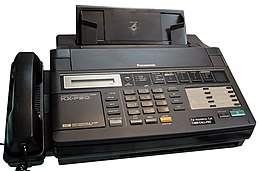

Fax (short for facsimile), sometimes called telecopying or telefax (short for telefacsimile), is the telephonic transmission of scanned printed material (both text and images), normally to a telephone number connected to a printer or other output device. The original document is scanned with a fax machine (or a telecopier), which processes the contents (text or images) as a single fixed graphic image, converting it into a bitmap, and then transmitting it through the telephone system in the form of audio-frequency tones. The receiving fax machine interprets the tones and reconstructs the image, printing a paper copy.[1] Early systems used direct conversions of image darkness to audio tone in a continuous or analog manner. Since the 1980s, most machines transmit an audio-encoded digital representation of the page, using data compression to transmit areas that are all-white or all-black, more quickly.
Initially a niche product, fax machines became ubiquitous in offices in the 1980s and 1990s.[2] They have largely been rendered obsolete by Internet-based technologies such as email and the World Wide Web, but are still used in some medical administration and law enforcement settings.[3]
- ^ Rouse, Margaret (June 2006). "What is fax?". SearchNetworking. Retrieved 25 July 2012.
- ^ Shapiro, Carl; Varian, Hal R. (1999). Information Rules: A Strategic Guide to the Network Economy. Harvard Business Press. p. 13. ISBN 978-0-87584-863-1.
- ^ Cite error: The named reference
:0was invoked but never defined (see the help page).